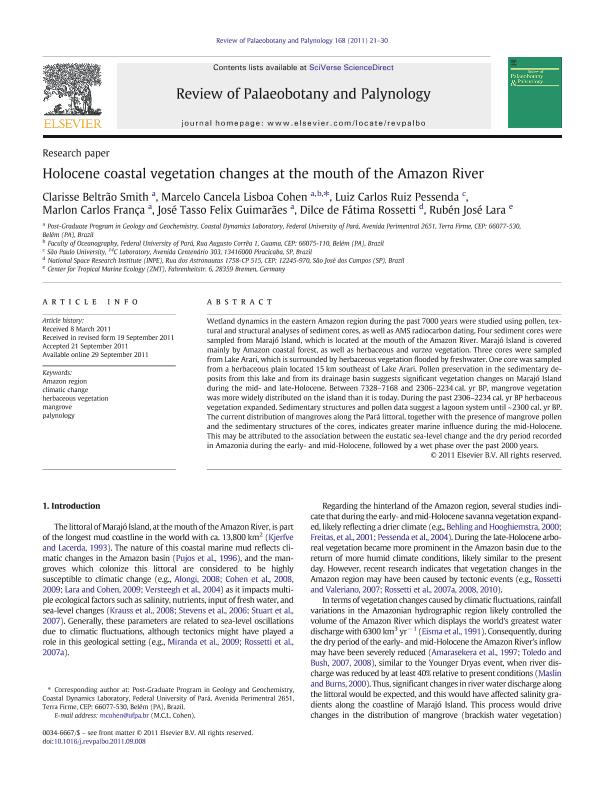Mostrar el registro sencillo del ítem
dc.contributor.author
Smith, Clarisse Beltrão
dc.contributor.author
Cohen, Marcelo Cancela Lisboa
dc.contributor.author
Pessenda, Luiz Carlos Ruiz
dc.contributor.author
França, Marlon Carlos
dc.contributor.author
Guimarães, José Tasso Felix
dc.contributor.author
Rossetti, Dilce de Fátima
dc.contributor.author
Lara, Ruben Jose

dc.date.available
2017-07-25T16:27:57Z
dc.date.issued
2011-08
dc.identifier.citation
Smith, Clarisse Beltrão; Cohen, Marcelo Cancela Lisboa; Pessenda, Luiz Carlos Ruiz; França, Marlon Carlos; Guimarães, José Tasso Felix; et al.; Holocene coastal vegetation changes at the mouth of the Amazon River; Elsevier Science; Review of Palaeobotany and Palynology; 168; 8-2011; 21-30
dc.identifier.issn
0034-6667
dc.identifier.uri
http://hdl.handle.net/11336/21269
dc.description.abstract
Wetland dynamics in the eastern Amazon region during the past 7000 years were studied using pollen, textural and structural analyses of sediment cores, as well as AMS radiocarbon dating. Four sediment cores were sampled from Marajó Island, which is located at the mouth of the Amazon River. Marajó Island is covered mainly by Amazon coastal forest, as well as herbaceous and varzea vegetation. Three cores were sampled from Lake Arari, which is surrounded by herbaceous vegetation flooded by freshwater. One core was sampled from a herbaceous plain located 15 km southeast of Lake Arari. Pollen preservation in the sedimentary deposits from this lake and from its drainage basin suggests significant vegetation changes on Marajó Island during the mid- and late-Holocene. Between 7328–7168 and 2306–2234 cal. yr BP, mangrove vegetation was more widely distributed on the island than it is today. During the past 2306–2234 cal. yr BP herbaceous vegetation expanded. Sedimentary structures and pollen data suggest a lagoon system until ~ 2300 cal. yr BP. The current distribution of mangroves along the Pará littoral, together with the presence of mangrove pollen and the sedimentary structures of the cores, indicates greater marine influence during the mid-Holocene. This may be attributed to the association between the eustatic sea-level change and the dry period recorded in Amazonia during the early- and mid-Holocene, followed by a wet phase over the past 2000 years.
dc.format
application/pdf
dc.language.iso
eng
dc.publisher
Elsevier Science

dc.rights
info:eu-repo/semantics/openAccess
dc.rights.uri
https://creativecommons.org/licenses/by-nc-sa/2.5/ar/
dc.subject
Amazon
dc.subject
Climate
dc.subject
Vegetation
dc.subject
Palynology
dc.subject.classification
Investigación Climatológica

dc.subject.classification
Ciencias de la Tierra y relacionadas con el Medio Ambiente

dc.subject.classification
CIENCIAS NATURALES Y EXACTAS

dc.title
Holocene coastal vegetation changes at the mouth of the Amazon River
dc.type
info:eu-repo/semantics/article
dc.type
info:ar-repo/semantics/artículo
dc.type
info:eu-repo/semantics/publishedVersion
dc.date.updated
2017-07-13T14:40:07Z
dc.journal.volume
168
dc.journal.pagination
21-30
dc.journal.pais
Países Bajos

dc.journal.ciudad
Amsterdam
dc.description.fil
Fil: Smith, Clarisse Beltrão. Federal University of Pará; Brasil
dc.description.fil
Fil: Cohen, Marcelo Cancela Lisboa. Federal University of Pará; Brasil
dc.description.fil
Fil: Pessenda, Luiz Carlos Ruiz. São Paulo University; Brasil
dc.description.fil
Fil: França, Marlon Carlos. Federal University of Pará; Brasil
dc.description.fil
Fil: Guimarães, José Tasso Felix. Federal University of Pará; Brasil
dc.description.fil
Fil: Rossetti, Dilce de Fátima. National Space Research Institute; Brasil
dc.description.fil
Fil: Lara, Ruben Jose. Consejo Nacional de Investigaciones Científicas y Técnicas. Centro Científico Tecnológico Conicet - Bahía Blanca. Instituto Argentino de Oceanografía. Universidad Nacional del Sur. Instituto Argentino de Oceanografía; Argentina. Center for Tropical Marine Ecology; Alemania
dc.journal.title
Review of Palaeobotany and Palynology

dc.relation.alternativeid
info:eu-repo/semantics/altIdentifier/doi/http://dx.doi.org/10.1016/j.revpalbo.2011.09.008
dc.relation.alternativeid
info:eu-repo/semantics/altIdentifier/url/http://www.sciencedirect.com/science/article/pii/S0034666711001400?via%3Dihub
Archivos asociados
